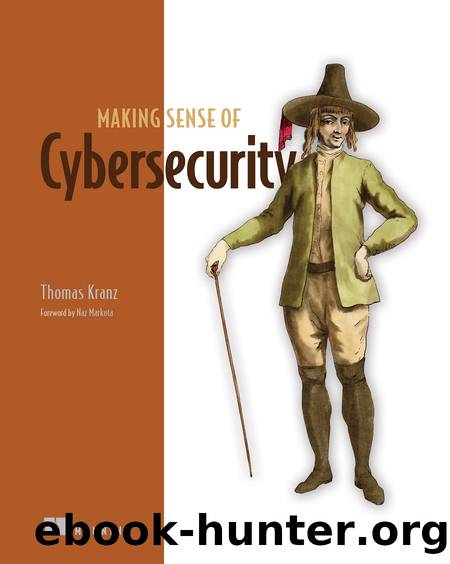Making Sense of Cybersecurity by Thomas Kranz;

Author:Thomas Kranz; [Kranz, Thomas]
Language: eng
Format: epub
Publisher: Simon & Schuster
Published: 2022-10-19T22:00:00+00:00
Moats around the castle (usually filled with water or nasty wooden spikes)
Multiple fortified internal structures (e.g., stables, grain storage, barracks)
Inner walls around some of the more important fortified structures
A further inner wall around the keep
Raising the keep and protecting its foundations
A second, smaller fortified gate, called a sally port, so that defenders could exit the castle safely and launch a counterattack
Figure 6.13 An evolution of the basic perimeter security castle design. The extra defenses make the design more complex but add much more security.
One of the secrets of the success of fortified centers like Warwick Castle is that they have evolved over time to take into account the evolving threats they face, created a constant feedback loop that analyzes the threats they face, and adapted their security measures to match them. Adding layers of security and new security technologies means we donât rely on one type of defense; weâre not relying on something like one gate, which is a single point of failure. Defense in depth is a concept fully embraced by Warwick Castle: when an attacker breaches one layer of defense, they have to start their attack all over again to breach the next level. We can apply the same idea to our example corporate infrastructure. As it stands, there is a single point of failure: a single, central firewall (figure 6.14).
Download
This site does not store any files on its server. We only index and link to content provided by other sites. Please contact the content providers to delete copyright contents if any and email us, we'll remove relevant links or contents immediately.
| Cryptography | Encryption |
| Hacking | Network Security |
| Privacy & Online Safety | Security Certifications |
| Viruses |
Effective Threat Investigation for SOC Analysts by Yahia Mostafa;(7098)
Practical Memory Forensics by Svetlana Ostrovskaya & Oleg Skulkin(6766)
Machine Learning Security Principles by John Paul Mueller(6752)
Attacking and Exploiting Modern Web Applications by Simone Onofri & Donato Onofri(6416)
Operationalizing Threat Intelligence by Kyle Wilhoit & Joseph Opacki(6386)
Solidity Programming Essentials by Ritesh Modi(4325)
Microsoft 365 Security, Compliance, and Identity Administration by Peter Rising(3933)
Operationalizing Threat Intelligence by Joseph Opacki Kyle Wilhoit(3686)
Future Crimes by Marc Goodman(3447)
Learn Computer Forensics - Second Edition by William Oettinger(3429)
Blockchain Basics by Daniel Drescher(3415)
Mastering Python for Networking and Security by José Manuel Ortega(3412)
Mastering Azure Security by Mustafa Toroman and Tom Janetscheck(3411)
Building a Next-Gen SOC with IBM QRadar: Accelerate your security operations and detect cyber threats effectively by Ashish M Kothekar(3251)
Incident Response with Threat Intelligence by Roberto Martínez(3158)
The Code Book by Simon Singh(3005)
Mastering Bitcoin: Programming the Open Blockchain by Andreas M. Antonopoulos(2941)
Mobile App Reverse Engineering by Abhinav Mishra(2922)
From CIA to APT: An Introduction to Cyber Security by Edward G. Amoroso & Matthew E. Amoroso(2824)
